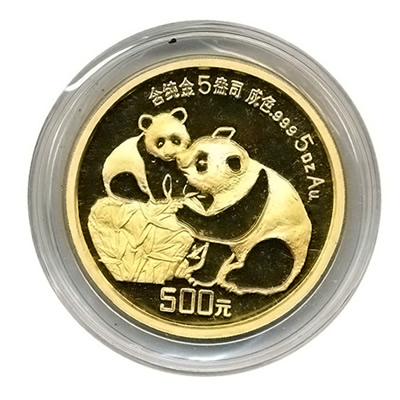Gold Panda Buying Guide
 With it s growing economy and swelling population of millionaires China has become a major player in gold investments. Since 1982 the Chinese government, keen to benefit from the trend, has been minting its own gold bullion coins – the handsome Gold Panda. There are growing numbers of these on the international markets and they’re an interesting choice, with extremely high gold purity and a reasonable premium over the spot price. In fact it’s a very popular coin and demand is consistently high.
With it s growing economy and swelling population of millionaires China has become a major player in gold investments. Since 1982 the Chinese government, keen to benefit from the trend, has been minting its own gold bullion coins – the handsome Gold Panda. There are growing numbers of these on the international markets and they’re an interesting choice, with extremely high gold purity and a reasonable premium over the spot price. In fact it’s a very popular coin and demand is consistently high.
The Coins
The Gold Panda is an official coin with legal tender status, and carries a face value, although as usual this is much lower than the actual value of its gold content. The standard coin weights one troy ounce and is made from 99.9 percent pure gold – apart from the Canadian Maple Leaf it’s one of the purest gold coins on the market. The face carries the words “People’s Republic of China” in Chinese script over an image of the Temple of Heaven. On the reverse is an image of pandas and the face value. For the 1 oz coin the face value is 500 Yuan. A series of smaller coins are also available; these are ½ oz /200 Yuan), ¼ oz (100 Yuan), 1⁄10 oz (50 Yuan) and 1⁄20 oz (25 Yuan).
All sizes share the same design as the 1 oz coin. One distinctive feature of the Panda is that the design on the reverse changes every year; it’s always pandas, but apart from 2001 and 2002 it’s always a different image. This is one of the factors behind the coin’s popularity.

Grades
Most Panda production is bullion grade, manufactured at a higher standard than many other bullion coins – they’re comparable to the “brilliant uncirculated” grade produced by many mints. Proof coins and sets are also available, distinguished by a multiple striking process that gives the relief a frosted appearance. These are intended for coin collectors and are best avoided by precious metal investors, as the purchase cost is considerably higher.
Investing In Pandas
Like all coins the Panda attracts a premium above the actual gold price – for a 1 oz coin this is usually around $100, which is in line with most similar coins. As usual the most economical way to buy is to concentrate on the larger coins as the premium makes up a lower percentage of their price.
A concern for coin collectors is that the authenticity of Pandas can be hard to determine – they’re produced in several mints throughout China and, unusually, there are no mint marks. The design of coins from each mint may differ slightly, and along with the annual changes that has made them an attractive target for counterfeiters. If your interest is in the gold content counterfeit coins may not worry you as long as the purity is correct, which is easily checked by weighing.
Similarly, because Pandas are 99.9 percent pure they’re very soft and vulnerable to damage. This can reduce their value to collectors but doesn’t affect the metal content, so secondhand coins in poor condition can be a cheap addition to your holdings.
The Gold Panda is a sought after coin that holds its value well. Less well known in the west than competitors like the Gold Eagle, Krugerrand and Sovereign, it’s still a quality coin with unusually high purity that makes a lot of sense as an investment vehicle. If accumulating pure gold is your priority we would definitely recommend having a look at this Chinese offering.
Next Page → Gold Krugerrand Buying Guide